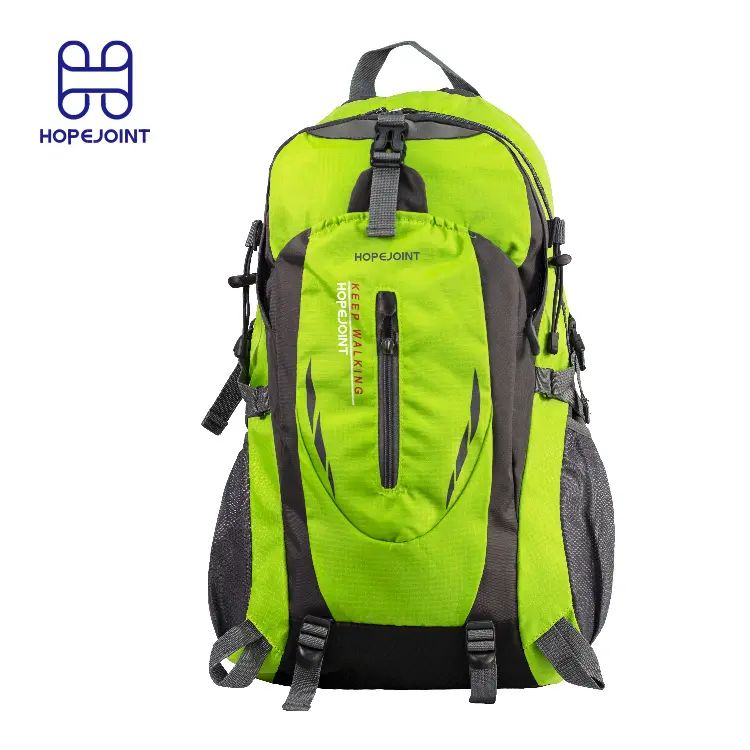
A hiking backpack is composed of the carrying system, the loading system and the plug-in system. It can be loaded with all kinds of supplies and equipment, including tents, sleeping bags, food and so on, within the load capacity of the pack, providing a relatively comfortable hiking experience for several days.
The core of a hiking backpack is the carrying system. A good hiking backpack with the right carrying way can do a great job of distributing the weight of the pack below the waist and hips, thus reducing pressure on the shoulders and feeling of being carried. This is all due to the carrying system of the pack.
The detail of the carrying system
1.Shoulder Straps
One of the most important parts of the carrying system. Large capacity hiking backpacks usually have thicker and wider shoulder straps so that we can get better support when hiking long. Nowadays, there are some brands that make lightweight hiking packs also have lightweight shoulder straps on their packs. It is important to note that before you buy a lightweight backpack, please lighten your outfit before placing an order.
2.Waist Belt
The waist belt is the key to transferring the pressure of the backpack, if we buckle the waist belt correctly and tighten it, we will obviously find that the pressure of the backpack has been partially transferred from the back to the waist and hips. And the waist belt can also play a fixed role, so that when we are hiking, the backpack᾽s center of gravity is always the same as the body᾽s.
3.Back Panel
The back panel of the hiking bag is now generally made of aluminum alloy, and there will also be carbon fiber material. And the back panel of the hiking bag used for multi-day hiking is generally a hard panel, which can play a certain supporting role. Back panel is the core of the carrying system.
4.Center of gravity adjustment strap
A new hand will be very easy to ignore this position. If you do not adjust this position, you will often feel the backpack pull you back. But when you adjust there, the overall center of gravity will be as if you were walking forward without backpack.
5.Chest belt
This is also a place that many people will overlook. Sometimes when you are hiking outdoors, you will see that some people don't fasten their chest belt, so if they encounter an uphill situation, they will easily fall because the chest belt is not fastened and the center of gravity shifts backward very quickly.
The above is basically the entirety of a hiking backpack's carrying system, and it determines how comfortable the bag is to carry. Besides, the correct and reasonable way of carrying is very necessary for a comfortable backpack.
1. Some hiking backpacks have adjustable back panels, so if you get a pack for the first time adjust the back panel first;
2. Load the right amount of weight inside the backpack to simulate the weight;
3. Lean forward slightly and buckle the waist belt, the center part of the belt should be fixed at our hip bone. Tighten the belt, but don't strangle it too tightly;
4. Tighten the shoulder straps so that the center of gravity of the backpack is further closer to our body, which allows the weight of the backpack to be better transferred below the waist and hips. Be careful not to pull it too tight here as well;
5. Buckle the chest belt, adjust the position of the chest belt to keep the same level with the armpit, pull tight but be able to breathe;
6. Tighten the center of gravity adjustment strap, but don't let the top bag hit your head. Keep the center of gravity slightly forward without the force pulling you backward.
In this way, we have basically learned how to carry a hiking backpack.
After realizing the above, we can easily know how to choose a suitable hiking backpack when hiking outdoors.
Nowadays, the hiking backpacks usually will be divided into large, medium and small size or male and female models to adapt to different heights of the applicable population, so we also need to measure own data when picking a backpack.
First of all, we have to find the hip bone (from the navel to the sides to touch, feel the protruding is the position of the hip bone). Then lower your head to find the neck protruding seventh cervical vertebrae, measure the length of the seventh cervical vertebrae to the hip bone, which is the length of your back.
Pick a size according to your back length. Some hiking backpacks also have adjustable back panels, so we should remember to adjust them to the right position after you buy them. If you are looking for a male or female model, you need to be careful not to choose the wrong one.
Post time: Oct-16-2023
